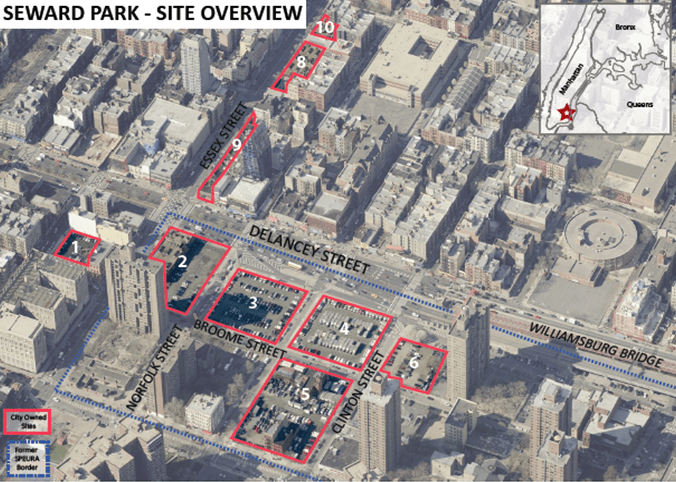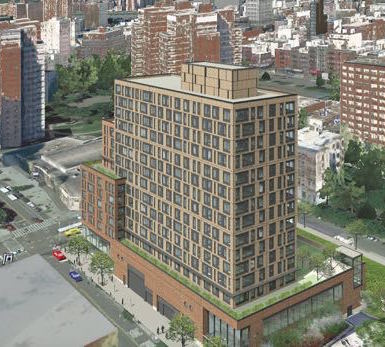
During the Bloomberg administration, city officials spearheading a giant Lower East Side mixed-use development larded it up with parking above and beyond what's normally allowed in Manhattan. Now, the company in charge of building the project says it's going to go parking-free, and is hosting a public meeting on its plan tonight. This could be a huge victory for Lower East Siders who want more housing but not more traffic and dirtier air, and it should be a lesson for the NYC Economic Development Corporation with far-reaching consequences.
The story of Essex Crossing, formerly known as the Seward Park Urban Renewal Area, or SPURA, goes back decades, but the latest chapter began a few years ago when the Bloomberg administration restarted the development process for long-dormant parcels near the foot of the Williamsburg Bridge. EDC hashed out a development proposal with neighborhood groups and Community Board 3 before securing permits from the City Planning Commission and selecting a developer to build the project.
EDC pushed for 500 parking spaces, replacing 400 surface parking spots and adding another 100 for good measure. Parking, you may have heard, is an obsession of car owners at community board meetings. To keep this constituency from going ballistic about its plans, EDC almost always proposes a net increase in the number of parking spots at its development sites, usually above what zoning requires or allows.
More parking leads to more cars clogging already-congested roads, but most community boards and elected officials eat up EDC's parking-saturated plans in the mistaken belief that tons of off-street parking will make it easier for car owners to find free on-street spaces.
Early versions of Essex Crossing, which spans nine city blocks above the confluence of four subway lines, included a 356-space municipal garage on Ludlow Street. To keep that cheap parking intact, the project's boundaries were redrawn in 2012 to avoid building over the garage. (Council Member Margaret Chin has since asked Mayor de Blasio to replace the garage with affordable housing.)
The nine parcels that remained in the six-acre plan included parking lots with 400 public spaces. The development's environmental impact statement estimated that it would need a maximum of 257 spaces, and the city's zoning code allowed no more than 345 spots. In the end, EDC got the City Planning Commission to sign off on a 500-car garage, above and beyond what zoning would normally allow for the project, which will consist of retail and commercial uses and 1,000 new housing units.
Soon after, EDC selected Delancey Street Associates LLC, a joint venture of L+M Development Partners, BFC Partners, and Taconic Investment Partners, to build the project. Earlier this month, the developer revealed that while it had permission to build a 500-space garage, the final project will be built entirely without parking, just like most of the rest of the neighborhood. To repeat, the government wanted to build 500 parking spaces, but now that the project has been handed off to the developer, the parking garages are gone.
There are plenty of reasons not to build parking garages. For one, they're expensive. New York City is the costliest place in the country to build structured parking, according to the Department of City Planning, at $21,000 per space. Sometimes, it can spike as high as $50,000 per space. That would put construction of a 500-space garage anywhere between $10.5 million and $25 million.
In this case, the parking was also done in by concerns about site constraints, congestion and street safety.

At a public meeting earlier this month, according to the Lo-Down, the project manager explained that the developer had initially planned on 100 parking spaces, not the 500 approved by the city. But even that smaller garage was eventually eliminated.
Because the development includes a multi-block sunken retail mezzanine called the "Market Line," the only place with enough remaining underground space to accommodate a parking garage was on just one of the project's nine parcels: Site 5, which occupies the full block between Broome, Grand, Suffolk, and Clinton Streets. The only location to squeeze in a garage entrance would have been on Clinton Street, the Lo-Down reports, and that posed a problem.
Clinton Street is a key connection from Grand Street to the Williamsburg Bridge, for drivers, pedestrians, and cyclists using the two-way protected bike lane along its western curb. The building on Site 5, which would contain apartments, retail, and a supermarket, would already add a loading dock to Clinton's western curb. Piling on a garage entrance would further degrade the street. It would also add to the crush of cars at the intersection of Delancey and Clinton, where DOT installed safety improvements after a driver killed 12-year-old Dashane Santana in the crosswalk in 2012.
Most members on the project's 10-person task force, created by EDC and CB 3 to represent local interests after the project received its planning approvals, agreed with the developer that adding parking ramps to Clinton Street would be a bad idea and sided with eliminating parking entirely.
The unhealthy obsession with parking is still alive and well in certain quarters, however, reported the Lo-Down:
At the meeting, speakers said they were worried about the impact of eliminating 500 spaces in a neighborhood that already has a parking shortage. Nancy Ortiz, tenant leader at the Vladeck Houses asserted, “it’s going to create a severe impact. (Parking) is not a luxury. It is a necessity.” Tim Laughlin, executive director of the LES Business Improvement District, also questioned the decision. The BID operates two of the parking lots for the benefit of local merchants. The organization stands to lose a significant amount of revenue when the lots are closed, although this would have been the case even if the developers had chosen to build new underground parking.
The BID did not respond to Streetsblog's request for comment. A second meeting on the development plan is scheduled for 6 p.m. tonight at the community room of Grand Street Settlement, 80 Pitt Street. Construction on the first phase of Essex Crossing is set to begin this summer.





